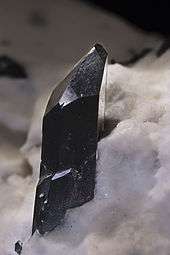Neptunite
| Neptunite | |
|---|---|
|
Neptunite crystals | |
| General | |
| Category | Phyllosilicate |
| Formula (repeating unit) | KNa2Li(Fe2+,Mn2+)2Ti2Si8O24 |
| Strunz classification | 9.EH.05 |
| Dana classification | 70.04.01.01 |
| Crystal system | Monoclinic |
| Crystal class |
Domatic (m) (same H-M symbol) |
| Space group | Cc |
| Unit cell |
a = 16.427(2), b = 12.478(2) c = 9.975(1) Å; β = 115.56(1)°; Z = 4 |
| Identification | |
| Color | Black; deep red-brown in thin fragments |
| Crystal habit | Prismatic or tabular |
| Twinning | Interpenetrant on {301} |
| Cleavage | {110} good |
| Fracture | Conchoidal |
| Tenacity | Brittle |
| Mohs scale hardness | 5-6 |
| Luster | Vitreous |
| Streak | Brown to red brown |
| Diaphaneity | Nearly opaque |
| Specific gravity | 3.19 - 3.23 |
| Optical properties | Biaxial (+) |
| Refractive index | nα=1.69-1.6908, nβ=1.6927-1.7, nγ=1.7194-1.736 |
| Birefringence | 0.0294-0.0452 |
| Pleochroism | x=yellow-orange, y=orange, z=deep red |
| 2V angle | 36° to 49° |
| Other characteristics | Piezoelectric |
| References | [1][2][3] |
Neptunite is a silicate mineral with the formula KNa2Li(Fe2+, Mn2+)2Ti2Si8O24. With increasing manganese it forms a series with mangan-neptunite. Watatsumiite is the variety with vanadium replacing the titanium in the formula.
It was first described in 1893 for an occurrence in the Narssârssuk pegmatite of West Greenland.[2] It is also found within natrolite veins in glaucophane schist within serpentinite in San Benito County, California, US. It also occurs in Mont Saint-Hilaire, Quebec and in the Kola Peninsula of Russia.[1]
The mineral is named for Neptune, Roman god of the sea because of its association with aegirine from Àgir, the Scandinavian sea-god.[2]
The Gemological Institute of America (GIA) identified an 11.78-carat faceted specimen as neptunite based on Raman spectroscopy.[4]

_sur_natrolite_et_serpentine_(USA)_2.jpg)